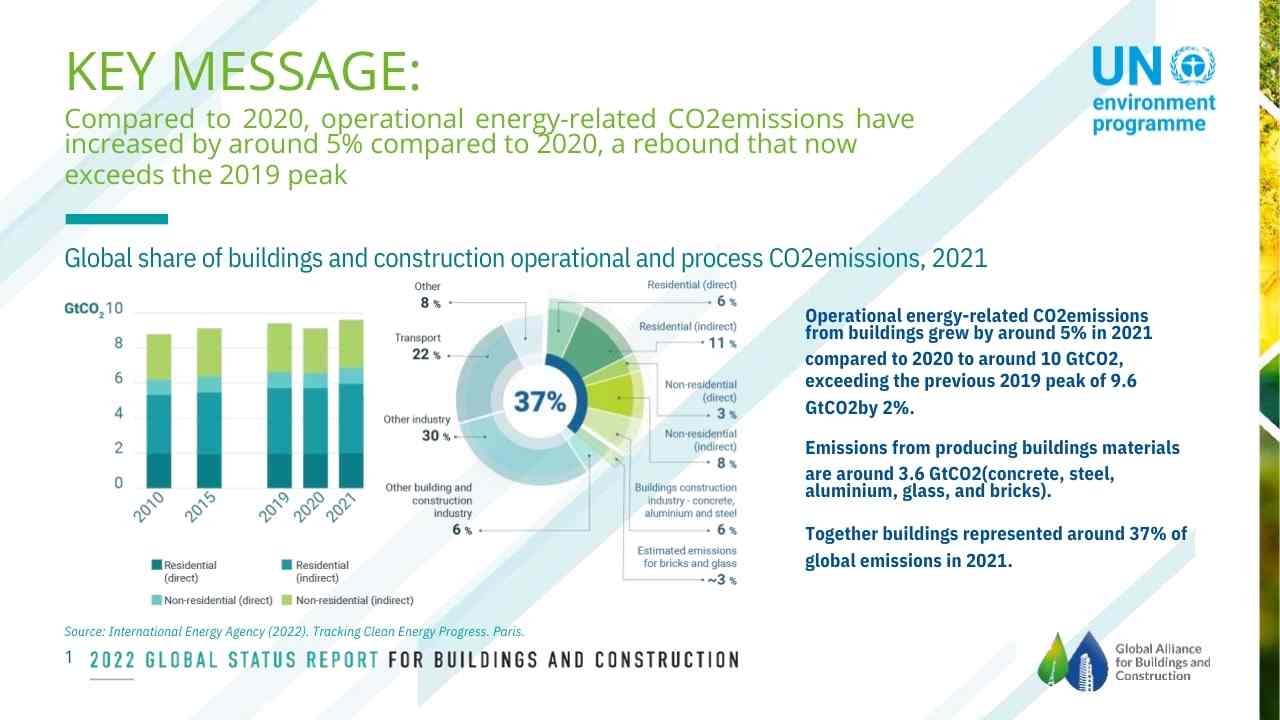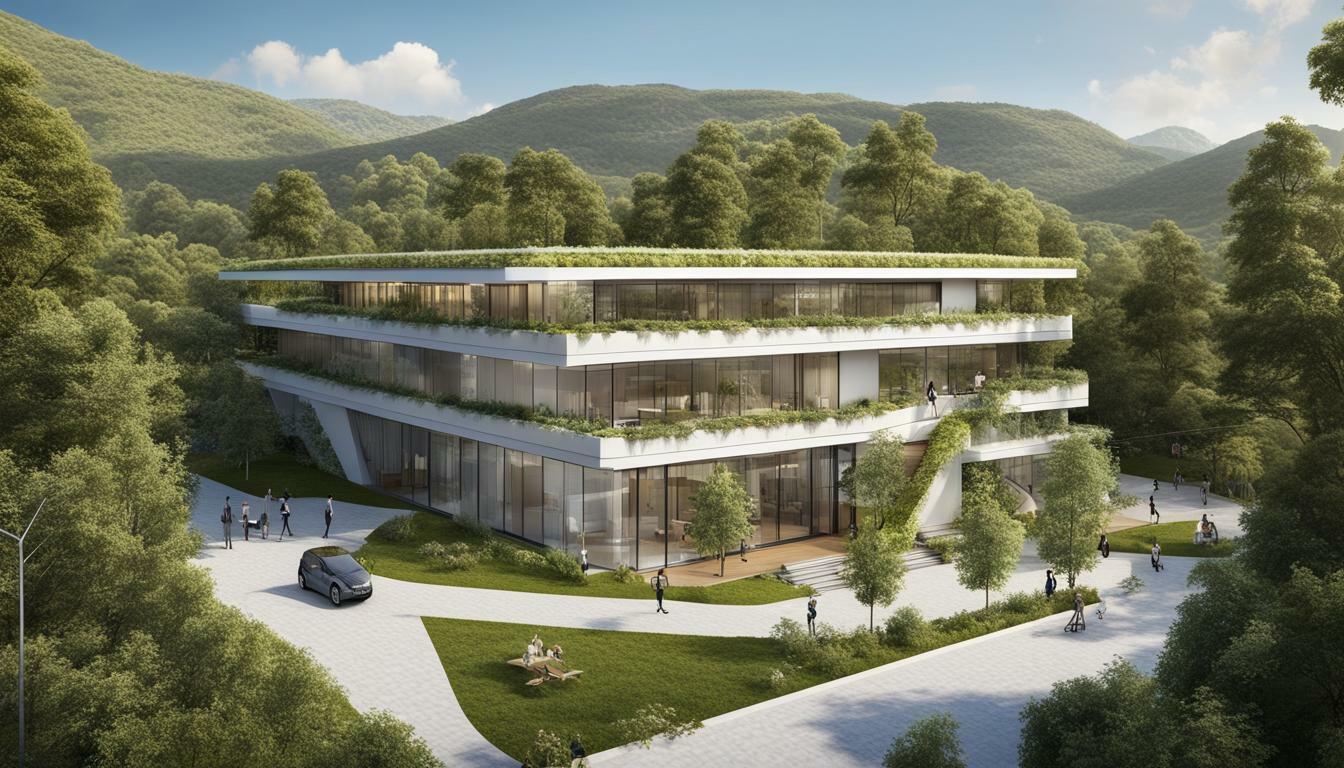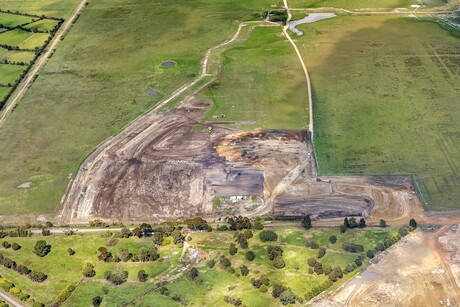Episode 46: What is the Post COP27 Roadmap for the Built Environment?
- Jackie De Burca
- November 14, 2022
What is the Post COP27 Roadmap for the Built Environment? With a Panel of Top Experts
COP26 saw the first-ever Built Environment Day
COP26 in Glasgow saw the first-ever Built Environment Day. Considering that one of the most shared statistics states that approximately 40% of global greenhouse gas emissions can be traced to constructing and maintaining buildings, some of you might be wondering if this is too little, too late.Listen here or on your favourite podcast app
Roland Hunziker, director of sustainable buildings and cities at the WBSCD, described built-environment emissions as “the sleeping giant.”Our panel of experts in this podcast episode will look honestly at the outcome of COP27 in terms of the built environment and also look back at what has happened in the year since COP26.
They will take into account information such as what is included in this first slide, from the 2022 Global Status Report for Buildings and Construction issued this week by the Global Alliance for Buildings and Construction (GlobalABC) and UN Environment Programme which clearly shows an alarming, clear key message:Compared to 2020, operational energy-related CO2 emissions have increased by around 5% compared to 2020, a rebound that now exceeds the 2019 peak.

“Only a radical transformation including all stakeholders along the value chain can help us break the trend” commented Roland Hunziker on LinkedIn about this message and slide.
Constructive Voices will speak to a panel of top experts on Monday 21st November and bring you that episode the very next day.
Below you can meet our guests and further down you can check the latest building initiatives announced at COP27 according to the BuildingtoCOP website.
Matthew Black, World Green Building Council
 Matthew is Programme Coordinator for World Green Building Council’s (WorldGBC) global Advancing Net Zero programme.
In this role, he works across the programme’s various global and regional activities and leads on the recruitment and delivery of the Net Zero Carbon Buildings Commitment.
He started his career in communications, previously working in Brussels for both the UN and a media company focused on sustainability, where his clients included: the UN, the EU Commission, Horizon 2020 research programmes, and a number of other international initiatives such as Cities4Forests.
Matthew is based in London, UK.
Matthew is Programme Coordinator for World Green Building Council’s (WorldGBC) global Advancing Net Zero programme.
In this role, he works across the programme’s various global and regional activities and leads on the recruitment and delivery of the Net Zero Carbon Buildings Commitment.
He started his career in communications, previously working in Brussels for both the UN and a media company focused on sustainability, where his clients included: the UN, the EU Commission, Horizon 2020 research programmes, and a number of other international initiatives such as Cities4Forests.
Matthew is based in London, UK.

Emma Nicholson, B.A, MSc, FCIOB, FIEMA, FWES, CEnv, FAPM, the Founding Director of Women in Sustainable Construction and Property
Emma is an accomplished and skilled Chartered Construction Manager and Chartered Environmentalist with Board level experience. She is currently the Principal Sustainability Project Manager, at Pick Everard, She is passionate about achieving quality projects and was nominated in 2018 for an Excellence Award in quality of project delivery of Leeds Art Gallery and Leeds Library roof restoration. Emma was a guest way back on Episode 13, How Women Can Create Sustainable Change, Especially in Light of the IPCC ReportSumele Adelana, Senior Strategic Marketing Manager for SketchUp at Trimble
 Sumele Adelana (RIBA Associate) uses her training and experience in architecture, interior architecture, and building performance design to create content that enables professionals in the AEC industry to leverage innovative technologies for better design and a more sustainable built environment.
She applies this knowledge in her role as the Senior Strategic Marketing Manager at Trimble’s SketchUp and in designing residential projects in the UK.
Sumele believes that architects are uniquely positioned to positively impact the day-to-day experience of people, communities, economies, and the global climate.
Through her work, she advocates for architects to see occupant comfort and building performance as a distinct criterion of great design, and for all AEC professionals to go beyond minimum regulatory requirements by analysing energy and daylight early and often as part of the design process.
Sumele was a also a guest on Episode 13, How Women Can Create Sustainable Change, Especially in Light of the IPCC Report
Sumele Adelana (RIBA Associate) uses her training and experience in architecture, interior architecture, and building performance design to create content that enables professionals in the AEC industry to leverage innovative technologies for better design and a more sustainable built environment.
She applies this knowledge in her role as the Senior Strategic Marketing Manager at Trimble’s SketchUp and in designing residential projects in the UK.
Sumele believes that architects are uniquely positioned to positively impact the day-to-day experience of people, communities, economies, and the global climate.
Through her work, she advocates for architects to see occupant comfort and building performance as a distinct criterion of great design, and for all AEC professionals to go beyond minimum regulatory requirements by analysing energy and daylight early and often as part of the design process.
Sumele was a also a guest on Episode 13, How Women Can Create Sustainable Change, Especially in Light of the IPCC Report
Phanos Hadjikyriakou, 2050 Materials
 Phanos Hadjikyriakou is an engineer and sustainability expert focusing on democratizing sustainable construction practices in the built environment.
He has a background in climate ESG assessments, and has worked with some of the biggest real estate institutions globally, helping them align their investments with a 1.5 degree world.
Currently, he is one of the co-founders of 2050 Materials, a company of architects, climate experts and software engineers building tools which empower architects and contractors to find, compare and specify the most sustainable building products available.
Phanos Hadjikyriakou is an engineer and sustainability expert focusing on democratizing sustainable construction practices in the built environment.
He has a background in climate ESG assessments, and has worked with some of the biggest real estate institutions globally, helping them align their investments with a 1.5 degree world.
Currently, he is one of the co-founders of 2050 Materials, a company of architects, climate experts and software engineers building tools which empower architects and contractors to find, compare and specify the most sustainable building products available.
Amrita Dasgupta Shekhar, Associate at Greengage
 Amrita is an Associate at Greengage and leads their Energy and Carbon services. She has over 15 years of experience working within the public, private and not-for-profit sector providing strategic leadership and management of carbon reduction programmes. Amrita is a part of a cross industry initiative to develop UK’s first Net Zero Carbon Building Standards. She is also a part of the British Property Federation’s sustainability committee and supports their work on Net Zero.
In her previous role with the Better Buildings Partnership, she worked with several Commercial Real Estate clients, to develop and deliver industry best practice relating to ESG. During this time Amrita led on the development of their Real Estate Environmental Benchmarks and managed the development of the NABERS methodology for Whole Buildings and Tenancy scheme for the UK.
She has successfully led the delivery of sustainable schools in Leicester, where her involvement has spanned from visioning, contract development to design and operational support. During this time she also delivered a successful soft-landings project on engaging and training building users to manage complex building systems and deliver incremental energy reductions in performance. These schools have demonstrated a significant reduction in the performance gap between actual and predicted energy use.
Amrita has significant experience of working on multi-stakeholder projects and has a multi-disciplinary approach to sustainable design and development. She has authored a number of technical and non-technical papers, guidance and toolkits on Sustainable Buildings and ESG issues in the UK as well as in international peer reviewed journals.
Amrita is an Associate at Greengage and leads their Energy and Carbon services. She has over 15 years of experience working within the public, private and not-for-profit sector providing strategic leadership and management of carbon reduction programmes. Amrita is a part of a cross industry initiative to develop UK’s first Net Zero Carbon Building Standards. She is also a part of the British Property Federation’s sustainability committee and supports their work on Net Zero.
In her previous role with the Better Buildings Partnership, she worked with several Commercial Real Estate clients, to develop and deliver industry best practice relating to ESG. During this time Amrita led on the development of their Real Estate Environmental Benchmarks and managed the development of the NABERS methodology for Whole Buildings and Tenancy scheme for the UK.
She has successfully led the delivery of sustainable schools in Leicester, where her involvement has spanned from visioning, contract development to design and operational support. During this time she also delivered a successful soft-landings project on engaging and training building users to manage complex building systems and deliver incremental energy reductions in performance. These schools have demonstrated a significant reduction in the performance gap between actual and predicted energy use.
Amrita has significant experience of working on multi-stakeholder projects and has a multi-disciplinary approach to sustainable design and development. She has authored a number of technical and non-technical papers, guidance and toolkits on Sustainable Buildings and ESG issues in the UK as well as in international peer reviewed journals.

Update from the Building to COP website, 17th November
Read the full list of initiatives that are collectively driving deep collaboration and triggering a positive systemic transformation in the built environment.
Building To COP Coalition member announcements:
Resilience:
- Buildings Breakthrough: government-level action
- WorldGBC Guide to Climate Resilience and Adaptation in the Built Environment
- Roof Over Our Heads
- Cities Race to Resilience
- Summary for Urban Policy Makers
Decarbonisation:
- 2030 Built Environment Breakthrough Outcome
- 2022 Global Status Report for Buildings and Construction
- An estimated 70% of the building stock expected to exist in 2040 has yet to be built.
- Building and construction sector is worth USD 5.4 billion and is expected to grow at a rate of 6.4% by 2024.
- Traditional sustainable construction and building practices are a cornerstone of African cultural heritage; used more widely they can make for more affordable housing that is adaptable to climate conditions.
- The Race to Zero continues
- Business of Climate Recovery: Accelerating Accountability, Ambition & Action
- Developing national and sub-national decarbonisation and resilience
- roadmaps to address energy performance and whole lifecycle emissions for new and old buildings.
- Placing whole life carbon at the centre of decarbonisation strategies and decisions.
- C40 Cities Clean Construction
- The cities of London and Milan joined C40’s Clean Construction Accelerator – endorsed by BWI, the global construction workers union, committing specific actions to support the global built environment sector in halving embodied emissions by 2030 and generating green jobs.
- Cities leadership and C40’s Clean Construction programme were recognised as supporting mechanisms to the new Buy Clean Initiative unveiled by the Biden/Harris administration in the White House Factsheet..
- IKEA Retail (Ingka Group) joined C40’s Clean Construction Action Coalition, launched last year at COP26 in Glasgow, to halve embodied emissions from the global built environment by 2030.
Finance:
- Paris Aligned Asset Owners
- Asset Managers in the Race to Zero
Marking an Opportunity for Africa:
- Africa Manifesto for Sustainable Cities and the Built Environment
- African Alliance for Sustainable Cities and Built Environments
Other Built Environment COP27 Announcements
- First Movers Coalition – The World Economic Forum and US Special Presidential Envoy for Climate announced at COP27 the expansion of a coalition of global companies to commit $12 billion in 2030 purchase commitments for green technologies to decarbonise the cement and concrete industry and other hard-to-abate sectors.
- 2030 Cement Breakthrough – from the UN High Level Climate Champions
- C40 released a new video demanding clean construction actions
Let’s look back at the built environment roadmap post COP26
According to the World Green Building Council, the outcome of Glasgow’s COP26 in terms of built environment was as follows:Accelerating deep collaboration: 26 built environment climate action initiatives announced at COP26
Marking a climate breakthrough for the built environment, a coalition of business and government groups announce 26 climate action initiatives at Cities, Regions and Built Environment Day at COP26, including:
- $1.2 trillion real estate assets under management are now a part of Race to Zero. As a front runner initiative in the Race to Zero, 44 businesses including developers, designers and asset managers representing $85 billion annual turnover sign World Green Building Council’s Net Zero Carbon Buildings Commitment to accelerate action to tackle whole life carbon emissions from the built environment by 2030.Responsible for almost 40 per cent of all greenhouse gas emissions, the built environment is fast becoming a driving force behind global climate change mitigation efforts.
- 1049 cities and local governments have joined Race to Zero. Representing 722 million people, this collective action has the potential to reduce global emissions by 1.4 gigatons annually by 2030. C40 Cities has launched a new Clean Construction Action Coalition of cities and construction sector companies today to connect and accelerate the just and fair change we need.
- Since 2015, 136 countries have included buildings in their Nationally Determined Contributions, an increase of around 55 percent; and 12 countries have made building decarbonisation commitments since 2018 — UK, Morocco, Mexico, France, Germany, Switzerland, Jordan, Chile, Kenya, Turkey, UAE, and Argentina.This is a significant step in the right direction to decarbonise economies as 65 per cent of population growth by 2030 will occur in countries that have NDCs that mention building energy efficiency and/or building codes to improve energy Performance.
- Representing nearly 300 million people, 75 RegionsAdapt members commit to joining the Race to Resilience; 33 cities join Cities Race to Resilience, aiming to 200 cities next year.
- The world’s building stock will double and almost 70 per cent of the global population is projected to live in urban areas.
- Global material use is expected to more than double and a third of this rise is attributable to materials used in the building and construction system.
- The built environment must be prioritised as a critical climate solution- Almost 40 percent of global emissions come from buildings and construction through their lifecycle, and buildings are responsible for almost 35 percent of final energy demand.
- We need faster and bolder government action, solutions and pathways to help drive change. Cities, regions and private sector frontrunners are already raising ambitions and accelerating progress but to fully realise the sector’s ambitions, they need an enabling regulatory framework and access to financing.
- We must rapidly accelerate deep cross-sectoral collaboration. This is critical for achieving the needed market transformation towards a zero-emission, efficient, and resilient built environment at scale and at pace.






